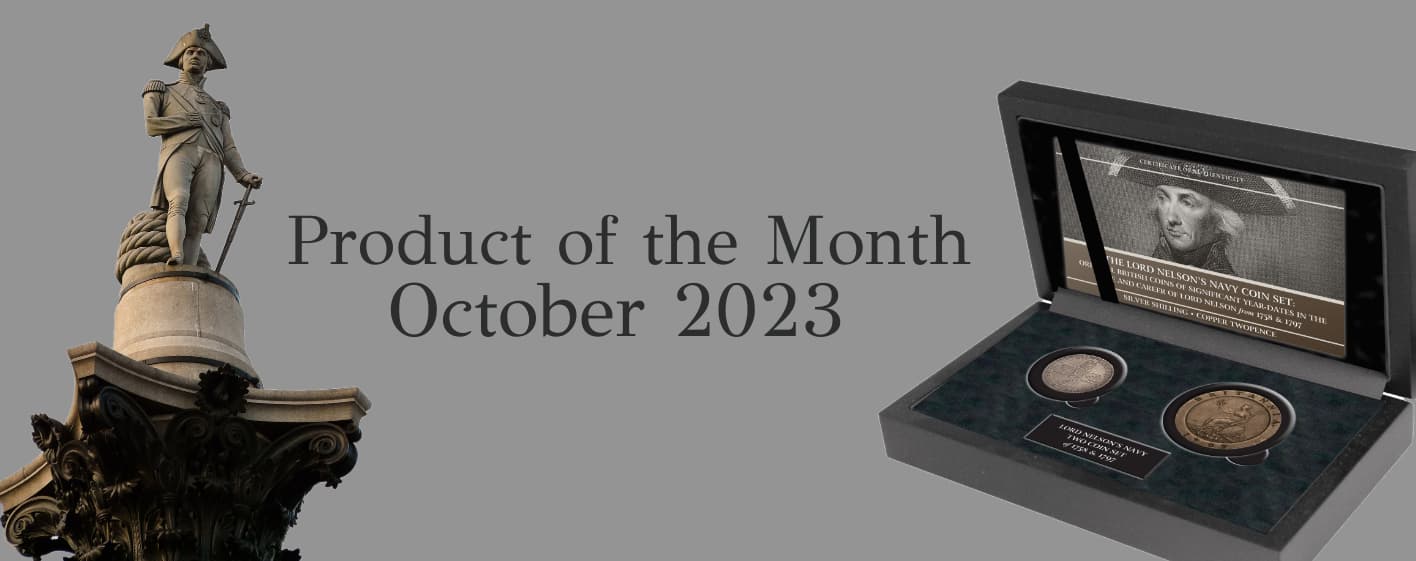
Featured as our Product of the Month for October, we have the unique Lord Nelson’s Navy Coin Set, which is comprised of coins that would have been used by the men in Nelson’s navy…
This set is comprised of two original British coins: a silver shilling and a copper twopenny both of which are significant year-dates in the life and career of Lord Nelson. Plus, they both have interesting stories to tell about the history of British coinage.
Nelson’s capture of the treasure ships Thetis and Santa Brigida in October 1799 was one of the most lucrative naval engagements in history. The prize-money was divided into eight and distributed to the officers and crew of the ship and the Commander-in-Chief of the station. This meant £13,000 (worth about £1.1m today) to Admiral John Jervis, who had left his post and returned to England due to ill health – making Nelson his unofficial successor – but he had not ‘officially resigned’. Nelson appealed to the Royal Navy for his share and in the end was awarded £10,000 (about £800,000).
THE SILVER SHILLING – The shilling is from the year 1758 and is also Grade 5, the very year Nelson was BORN, and it is the very last silver shilling of the reign of King George II.
In this era, the shilling was known as ‘the king’s shilling’ boasting a notoriety unmatched by any other item of British currency. ‘Taking the king’s shilling’ was the traditional reward for enlisting in Britain’s army and navy. In return for enlisting, a volunteer received a bounty of one shilling – a handsome sum at a time of low wages and near-poverty. This was especially rife around the time of the wars in the Americas and against Napoleon – a time at which this was one of the ‘King’s shilling’ coins in circulation. Even after the wars, ‘Shilling’ remained a common term for enlisting.
There are recurring tales of sailors being drafted into the navy after a shilling was slipped into their drink which they were deemed to have ‘accepted as payment’ if they finished the drink. This led to glass-bottomed tankards. However, this is likely to be a myth, because the Navy could press by force, rendering deception unnecessary.
THE COPPER TWOPENCE – The copper coin is the 1797 twopence in Grade 6, and this is from the year Nelson was first awarded the rank of Admiral. His rank was ‘Rear Admiral of the Blue’: Rear Admiral is the third highest rank of Admiral behind Vice Admiral and Admiral, and ‘the Blue’ refers to the Blue Squadron of the Royal Navy which, at the time was divided into Red, White and Blue squadrons. This twopence is the ONLY coin of its type ever minted in Britain.
The reign of King George III had seen incredible upheaval in the price of precious metals and so the production of all coins was impacted. These twopence coins were minted not in the Royal Mint in London but at the Soho Mint in Birmingham, by Matthew Boulton who had installed a new steam-powered coin press. A product of the Industrial Revolution, this press enabled far more pressure to be exerted in the striking of the coins, which in turn meant they could be far more uniform in size and a far higher quality impression be made.
It was quickly dubbed the ‘cartwheel’ – but it was unpopular because it was easily damaged if dropped, and could also do serious damage to your toes! Its fate was sealed when the world copper price rose in 1805 and you could make a 25% profit by melting them!
Housed together in a luxury presentation case with a Certificate of Authenticity, secure yours HERE.
